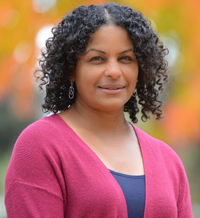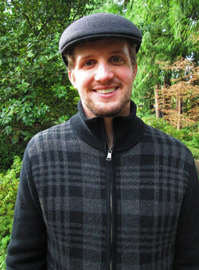"Everyone Has a Name":
Holocaust Remembrance Day
For Sunday May 4, 2008
Lectionary Readings (Revised Common Lectionary, Year A)
Acts 1:6–14
Psalm 68:1–10, 32–35
1 Peter 4:12–14; 5:6–11
John 17:1–11
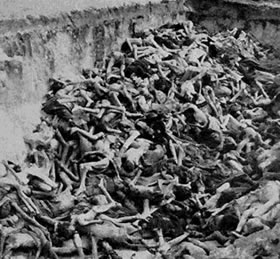 |
Mass grave at Auschwitz. |
On May 1 the world commemorates the genocide of six million Jews in the Holocaust by observing Yom Hashoah — Holocaust Remembrance Day. In 1951, Israel's parliament designated the 27th day of Nissan as Holocaust Day, a day to remember the Jews who perished and those who heroically resisted. In 1959, the parliament designated Holocaust Day as formal law. Since 1989, the Knesset, in cooperation with Yad Vashem — The Holocaust Martyrs' and Heroes' Remembrance Authority, performs a ceremony called "Everyone Has a Name" in which the names of all of the Holocaust victims are read aloud.
The term “genocide” has a specific history. The word was coined by the eccentric and brilliant Raphael Lemkin, a Polish Jew who almost single-handedly thrust the issue of genocide onto the world stage. On October 16, 1950, after seventeen years of Lemkin’s tireless labor, the Convention on the Prevention and Punishment of the Crime of Genocide was finally ratified by the United Nations. By the time the United States signed thirty-six years later on February 11, 1986, ninety-seven nations had already ratified the convention.
When Lemkin died of a heart attack at the age of fifty-nine on August 28, 1959, he was penniless. Before he died he broadened the notion of genocide beyond the extermination of six million Jews. "Lemkin had nearly completed a magisterial analysis of a long list of historical cases and themes of genocide, which remains unpublished." He expanded genocide to include "the attempted destruction not only of ethnic and religious groups but of political ones, and [thought] that the term should also encompass systematic cultural destruction" (Kiernan).
Most of us are familiar with the world’s major genocides — Armenians, Jews, Cambodia, Iraqi Kurds, Bosnia, Rwanda, Srebrenica, Kosovo, and now Darfur. In his 700-page study called Blood and Soil; A World History of Genocide and Extermination from Sparta to Darfur (2007), Ben Kiernan, the founding director of Yale's Genocide Studies Program, identifies four "telltale characteristics" of genocides that have recurred over the last 600 years. Perpetrators of genocide, he says, tend to be preoccupied with utopian or idealized notions of (1) ethno-religious racism, (2) cults of antiquity to restore pure and pristine origins, (3) agricultural idealism and conflict over land, and (4) territorial conquest and expansion.
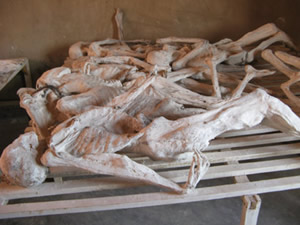 |
Part of the Rwanda Genocide Memorial. |
No person or people is immune from the horrors of holocaust, either as a perpetrator or a dissenter. Solzhenitsyn once observed in his Gulag Archipelago that it would be nice if we could neatly divide the world between the insidiously evil and the obviously good. Instead, he wrote, “the line dividing good and evil cuts through the heart of every human being.” There can be good "bad" people, for example. A Holocaust survivor once described to me how a young Nazi guard secretly gave him a sandwich, and as he did, tears streamed down the soldier's cheeks.
Conversely, there can be bad "good" people. In his book Unspeakable Acts, Ordinary People: The Dynamics of Torture, John Conroy says that we tend to caricature torturers as sadistic monsters. But “there is ample evidence that most torturers are normal people, that most of us could be the barbarians of our dreams as easily as we could be the victim.” Consider the following example from Christian history.
The Spaniards came to America for gold and glory, but they also came for God, to spread the Gospel. In a letter to Pope Alexander VI, February 1502, Columbus wrote of his goal in the new world: “I hope in Our Lord to be able to propagate His holy name and His Gospel throughout the universe.” The natives they encountered were deemed pagan and subhuman, as their cannibalism and human sacrifices surely "proved." Oviedo, a 16th-century conquistador and historian of the five volume work Natural History of the West Indies, describes the solution to the problem of Indians who did not want to convert:
God is going to destroy them soon. . . . Satan has now been expelled from the Island [Hispaniola]; his influence has disappeared now that most of the Indians are dead. . . . Who can deny that the use of gunpowder against pagans is the burning of incense to our Lord?
The results of these evangelistic efforts? Tzvetan Todorov estimates that the Spanish conquest of the Americas killed 70 million people by murder, maltreatment such as slavery, and disease — about 90% of the population. In this example, "good" Christians construed the wholesale genocide of "bad" Native Americans as wholehearted piety.
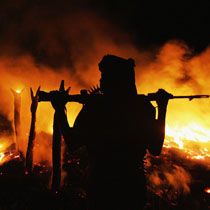 |
The Darfur village of Chero Kasi burns after government-supported Janajaweed militia set it ablaze. |
Genocides don't have to happen. We are not destined to slaughter our neighbor. But when we reduce people to a singular identity (Jew! Gay!), it feeds a sense of fatalism, resignation, and a sense of inevitability about violence. Simplistic labels partition people and civilizations into binary oppositions. They ignore the plural ways that people understand themselves, and obscure what Amartya Sen calls our "diverse diversities." In particular, Sen objects to the "clash of civilizations" thesis made popular by Samuel Huntington. No, we should never concede that civilizations have to clash.
Sen argues against identity violence caused by the illusion of destiny in three ways. First, he appeals to our common humanity; everyone laughs at weddings, cries at funerals, and worries about their children. More important than any of our external differences, even though these are powerful and important, is our shared humanity. Everyone has a name, a name known and loved by God. Every one of us, Paul affirmed, is "God's off-spring" (Acts 17:29).
Second, he makes the obvious point that all people enjoy plural identities. To understand a person one must consider factors of civilization, religion, nationality, class, community, culture, gender, profession, language, politics, morals, family of origin, skin color, and a multitude of other markers. Plus, these diverse differences within a single individual depend on one's social context, whether the trait is durable over time, relevant, a factor of constraint or free choice, and so on. People are complex; we shouldn't reduce them to a single trait.
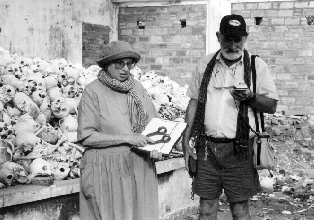 |
Cambodia's Tuol Sleng Museum of Genocide. |
Finally, Sen urges us to transcend the illusion of destiny and identity violence by what he calls "reasoned choice." Instead of living as if some irrational fate destines us to slaughter others who are different, a person needs to make a rational choice about what relative importance to attach to any single trait. Although Sen never explains why rational people succumb to the irrational violence of identity, instead of choosing enlightened self-interest, economic incentives, and geo-political peace, he reminds us of the obvious: "We can do better."
I pray to move to the place described by the Yale theologian Miroslav Volf in his book Exclusion and Embrace: “The theme of divine self-donation for the enemies and their reception into the eternal communion of God. . . . As God does not abandon the godless to their evil but gives the divine self for them in order to receive them into divine communion through atonement, so also should we — whoever our enemies and whoever we may be.” Thus the embrace beyond exclusion — “the will to give ourselves to others and to ‘welcome’ them, to readjust our identities to make space for them, is prior to any judgment about others, except that of identifying them in their humanity.”
For further reflection
* Consider the words of the German pastor Martin Niemoeller (1892–1984), who protested Hitler's anti-semitic measures in person to the fuehrer, was eventually arrested, then imprisoned at Sachsenhausen and Dachau (1937–1945). He once confessed, "It took me a long time to learn that God is not the enemy of my enemies. He is not even the enemy of His enemies."
* Consider the poem ascribed to Niemoeller (although its different versions and exact origins are debated), First They Came. The poem describes the passivity of German intellectuals as the Nazis purged group after group of targeted people.
First they came for the Communists,
- but I was not a communist so I did not speak out.
Then they came for the Socialists and the Trade Unionists,
- but I was neither, so I did not speak out.
Then they came for the Jews,
- but I was not a Jew so I did not speak out.
And when they came for me, there was no one left to speak out for me.
And for further reading see below. Except for the books by Wiesel and Todorov, all of the following are reviewed in the book and film review pages of JwJ.
* Philip Gourevitch, We Wish to Inform You That Tomorrow We Will Be Killed With Our Families; Stories From Rwanda (1998).
* Samantha Power, A Problem From Hell; America and the Age of Genocide (2002).
* Amartya Sen, Identity and Violence; The Illusion of Destiny (2006).
* Brian Steidle, The Devil Came on Horseback; Bearing Witness to the Genocide in Darfur (2007).
* Tzvetan Todorov, The Conquest of America: The Meaning of the Other (1984).
* Elie Wiesel, Night.
* Watch the films Forgiving Dr. Mengele; Paper Clips (about a school project to collect one paper clip for every victim of the Holocaust); and Promises (about Israeli and Palestinian children).
Image credits: (1) David's Medienkritik-Online; (2) www.theworld.org; (3) Scott Nelson, Getty Images; and (4) Cambodia Genocide Program, Yale University.




